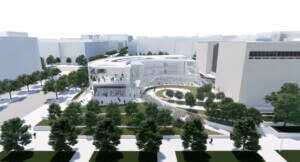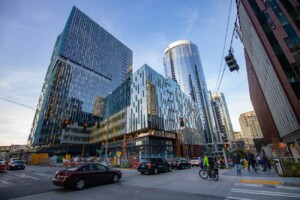In May 2019, Jeff Bezos made his case for why and how humans will occupy space, in a presentation titled “Going to Space to Benefit Earth.” The original presentation was made to a relatively small audience but is also viewable on the website of Blue Origin, the Bezos-owned spaceflight and rocketry company. In little less than an hour, he made the argument that for humans to continue to evolve and improve their living standards, we will need access to more resources and environments than the earth has to offer us. As part of the presentation, Bezos described his vision for what the off-planet colonies will look like and the short-term goals required to make them a reality.
While most of the emphasis was placed on those short-term goals, which are to colonize and extract resources from the moon, the more compelling section of the presentation focused his long term goal for off-planet environments. Using a series of illustrative animations, Bezos explained how humans could inhabit space using O’Neil cylinders. This is technology initially imagined in the 1970s by Princeton University physics professor Gerard O’Neil. There are plenty of other people, such as Fred Scharmen, who have already written about the history behind extraterrestrial colonies and their cultural impacts, so instead, I would like to focus on the even older representational techniques that influenced Blue Origin’s vision of the future.
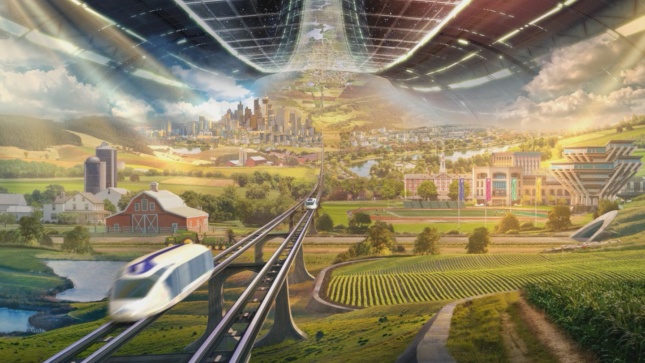
Bezos used four images to illustrate and emphasize a set of important points that he makes to re-enforce his vision. The first of these points is that Blue Origin’s space habitats would not be made up of larger versions of the international space stations but of manmade environments capable of supporting populations that are the equivalent of small to medium-sized cities. The second is that these orbital landscapes could vary in use (and simulated gravity through the adjustment of their rotational speeds), including recreational, farming, and technical purposes. The third is, that despite being removed from the surface of the Earth, the architecture could be made to be both visionary and familiar, allowing colonizers to maintain their cultural and spatial references while experimenting with novel landscapes.
Despite being new natures, the landscapes and ecologies presented by Blue Origin were highly familiar places. This was an important part of the presentation because it allowed the audience to imagine themselves as potentially occupying these places. The representational devices used in the renderings are part of a long tradition of landscape painting: most notably, passive cues that make the occupation of unfamiliar landscapes imaginable and palatable.
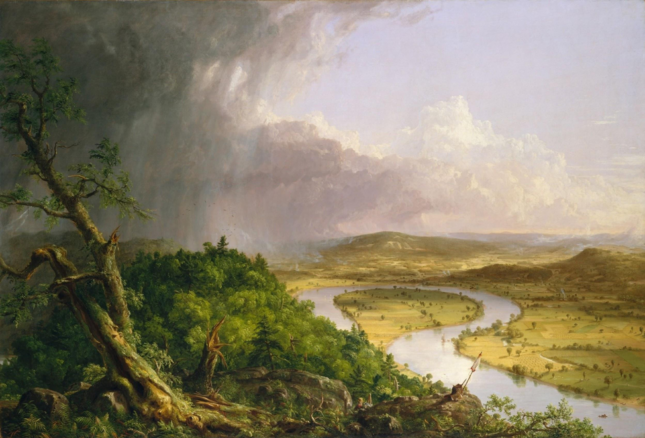
For comparison, Thomas Cole and other artists of the Hudson River School created paintings that normalized the 19th-century expansion into the Northeastern United States. They celebrated agriculture and other methods of organizing nature to the benefit of European colonizers, “taming” what they saw as a wild place. Nature has been historically used as an adversary to be conquered in the form of weather and difficult-to-traverse topography.
An example of this can be seen in the painting View from Mount Holyoke, Northampton, Massachusetts, after a Thunderstorm—The Oxbow by Thomas Cole. The painting illustrates an artist on a hill facing storm clouds and farmland in the distance. The use of perspective and distance used in the Blu Origin images echo the rules used by Cole, with the only significant difference being the threat that the environment poses.
One of the animations places a stag on a mountain in the center foreground of the rendering. In the background, there is an expanse of artificial wilderness with a city in the distance. To the right of the stag, an eagle or other large bird of prey flies effortlessly through the cylinder. Adjacent to the settlement in the image, the earth slowly rotates into view from behind the wilderness section. Instead of the thunder clouds seen in Cole’s work, the sky has been replaced with the dark void beyond the structure’s enclosure and stars, with the explicit understanding that this is an off-planet landscape surrounded by a vacuum.
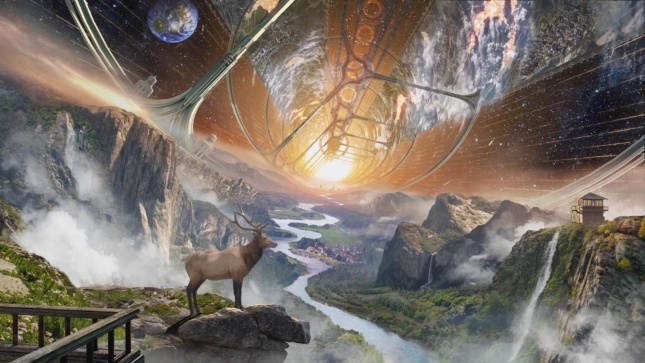
In another animation, a city is present in the background and passenger cars moved along a light rail. The presence of rain seen in Thomas Cole’s painting has been replaced with a drone watering crops as it drifts over land designated for agricultural use. Weather in these spaceborne enclosures, specifically rain events, would be fabricated and controlled by necessity. However, using drones to create rain events also speaks towards a need to experience weather to simulate “nature” to the highest degree possible. The drones provide a service, but they also normalize an extremely artificial landscape.
The final two animations illustrated two forms of off-world urbanism. In one of the images, the “city” was created by collaging together a series of important architectural constructions and streetscape seen across the world. From one vantage point, a resident would see a blend of Swiss, Italian, and Chinese architecture. Architecture would work as a comforting set of references for the residents, tying them back to the Earth-bound cultural environments perceived as being valuable. This vision was a more densely populated habitat of tall buildings, parks, and athletic fields. As is the case with the landscapes, the city animations sampled a narrow segment of the Earth, and were meant to attract interest from a narrow segment of people. The primary audience is the people that were present in the auditorium, sharing privileged worldviews and experiences, who would recognize the imagery being referenced.
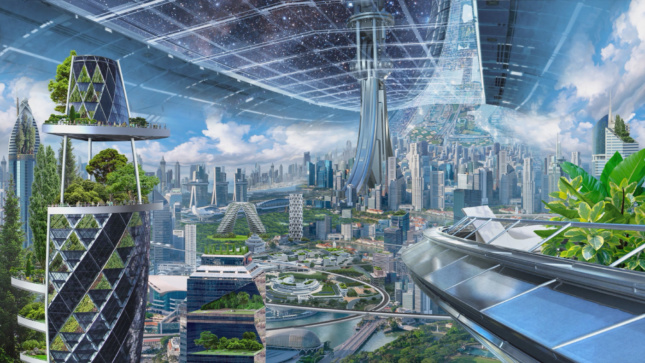
The animations shared by Blue Origin represent a complex set of ideas and allowances. They presented a chance to revisit the romantic mythologies that the adults in the audience saw in their college art history courses. At the same time, those renderings validate their commitment to a future where technology is the best means to advance humanity. Like the Cole painting, they justify the presence of people in space habitats through the use of positive pastoral imagery.
This leads to what is arguably the real goal of the presentation—building enthusiasm for resource extraction on the moon. Jeff Bezos makes it clear that the moon would need to be mined for the resources that would make these space habitats economically viable. He also stated that space would provide a limitless amount of resources for expansion. This is an argument of expansion and capitalism, one that edges out conservation on Earth. There is an implicit assumption that increased exploration will make the materials cheaper. This is an argument that has been made many times before, including in 1492 when Columbus lobbied for the investments that would allow him to reach the Bahamas.
Marc Miller is currently an assistant professor at the Penn State Landscape Architecture Stuckeman School.








